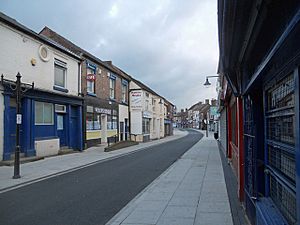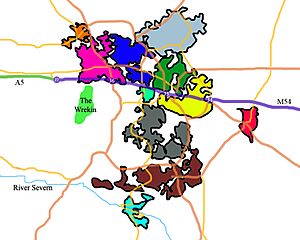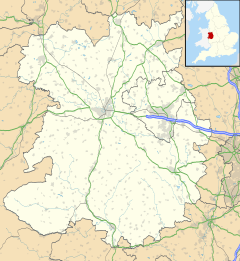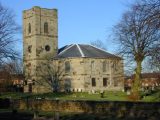Dawley facts for kids
Quick facts for kids Dawley |
|
|---|---|
| Town and civil parish | |
 High Street, Dawley |
|
| Population | 11,399 |
| OS grid reference | SJ686068 |
| Civil parish |
|
| Unitary authority | |
| Ceremonial county | |
| Region | |
| Country | England |
| Sovereign state | United Kingdom |
| Post town | TELFORD |
| Postcode district | TF4 |
| Dialling code | 01952 |
| Police | West Mercia |
| Fire | Shropshire |
| Ambulance | West Midlands |
| EU Parliament | West Midlands |
| UK Parliament |
|
Dawley is a town in Shropshire, England. It is part of the larger area known as Telford and Wrekin. Dawley was first planned to be the main center for a new town in 1963. However, in 1968, it was decided to name the new town 'Telford'. This name honored Thomas Telford, a famous engineer and road-builder.
Dawley is one of the oldest settlements in Shropshire. It was even mentioned in the Domesday Book from 1086. The town is split into two parts: Dawley Magna (meaning "Great Dawley") and Little Dawley. Sometimes Little Dawley is called Dawley Parva on older maps.
Contents
What's in a Name?
The name Dawley comes from an old English phrase. It means a "woodland clearing" that was linked to a man named Dealla.
Dawley's History
Dawley has a long and interesting past. It was mentioned in the Domesday Book, which shows it's a very old place.
The Mystery of Dawley Castle
There used to be a castle in Dawley. It was taken down around 1648. No one knows exactly where it stood today. However, places like Castle Pools and Castle Ironworks might give us a clue. These names suggest the general area where the castle could have been. Before the area was changed for Telford New Town, old maps showed castle ruins near Castle Pools. But in the 1980s, the whole area was covered up and planted with trees. The famous Ironbridge is also not far from Dawley.
Mining and Industry
For over 300 years, Dawley was a busy mining town. People mined for both coal and ironstone here. Clay was also dug up for factories that made industrial pipes, bricks, and pottery. Mining had a big effect on the local way of life.
In 1821, workers at Dawley's ironworks stopped working. They were protesting because their wages were being lowered. Many of these workers joined a larger protest known as the Cinderloo Uprising. Later, in 1872, a sad event happened called the Springwell Pit Disaster. Eight men and boys lost their lives in this mining accident.
Before Telford New Town was built, the area had many clay mounds and large clay pits. These were so common that local people used them as landmarks. Even today, there's a clay-pipe factory nearby in Doseley village.
Local Landmarks and Traditions
The Dawley Town Hall first opened in 1873. It was built as a place for people to meet and avoid alcohol.
In 2010, Dawley got a lot of attention. Some local people created a sign on Paddock Mount that looked like the "Hollywood" sign. But instead, it spelled out "Dawley"! This fun effort was celebrated by the local newspaper. Many people supported the sign online.
Dawley was also known for its unique dialect. It had special words like "bist," which meant "are." Sadly, most of this dialect is now lost. Another tradition was the "pig on the wall." People in Dawley would put their pigs on their walls to show support for local bands or parades. There was even a romantic phrase: "I wudna swop thee for a big black pig!"
Getting Around Dawley
The closest train station is Telford Central. Long ago, a railway line passed through Dawley. It went through a tunnel at Heath Hill. This tunnel is still used today. It's part of the Telford Steam Railway's plans to expand. There was also a station called Dawley and Stirchley railway station. It was on the Coalport Branch Line. This line opened in 1860 but closed in 1952. The old track is now part of the Silkin Way, a walking and cycling path.
Dawley's Geography
Dawley has a street market every Friday. The town center has one street just for pedestrians. This street used to be the main road connecting Bridgnorth to Wellington. The areas around Dawley that are not part of Telford New Town are rural. They offer great places for walking. The Ironbridge Gorge and The Wrekin are both nice walks from Dawley.

On the northern edge of Dawley is Malinslee. Here you can find St. Leonards church. The church's design is a bit unusual, shaped like an octagon. People say its design was influenced by Thomas Telford. Other churches nearby, like in Madeley and Bridgnorth, were also supposedly influenced by him.
Schools in Dawley
Dawley has seven primary schools. It also has one main secondary school, Telford Langley School. There are two special schools in Dawley: Queensway South campus and Southall School.
Famous People from Dawley
Many interesting people have connections to Dawley:
- Samuel Peploe (1667-1752) was born in Little Dawley. He later became a Bishop.
- Thomas Botfield (1762-1843) was born in Dawley. He was a metallurgist, geologist, and inventor.
- William 'Billy' Ball (1795–1852) was known as the Shropshire Giant. He was a very tall iron worker.
- Captain Matthew Webb was born in Dawley in 1848. He was the first person to swim the English Channel! His monument stands on the High Street. Two roads and a primary school in Dawley are named after him.
- William Foulke (born 1874) was a famous football goalkeeper. He played for England.
- Joe Butler (born 1879) was another professional football goalkeeper. He played many games in The Football League.
- Joseph Simpson (1909-1968) was born in Dawley. He became the head of the London Metropolitan Police.
- Edith Pargeter (1913-1995) went to school in Dawley. She wrote the popular Brother Cadfael mystery novels under the name Ellis Peters. Many roads in Aqueduct are named after her books and pen name.
- Roy Pritchard (1925-1993) was a professional footballer. He played for teams like Wolverhampton Wanderers.
- Thomas (aka Tommy) Nicholls (1931-2021) was a boxer. He lived in Dawley when he competed in the Olympics in 1952 and 1956.
- Eddie Garbett (born 1949) was a footballer for teams like Shrewsbury Town.
- Paul Hendy (born 1966) is a TV presenter. He was born in Dawley.
- Danielle Jones, a character from the TV show EastEnders, was said to be from Dawley.




